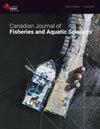利用底栖繁殖密度预测加拿大大西洋美洲龙虾的渔业繁殖情况
IF 1.9
2区 农林科学
Q2 FISHERIES
Canadian Journal of Fisheries and Aquatic Sciences
Pub Date : 2024-06-12
DOI:10.1139/cjfas-2023-0277
引用次数: 0
摘要
自 20 世纪 80 年代中期以来,加拿大美洲龙虾上岸量出现了明显的时空变化趋势,但人们对其背后的机制了解有限,预测变化的能力也很低。我们为加拿大的三个龙虾捕捞区(LFAs)建立了一个基于个体的模型,该模型利用育苗场底栖新龙虾的年密度生成未来6到10年的可开发生物量指数,使用冯-贝塔朗菲生长方程,并辅以个体间的生长变异性、区域成熟度系数和产卵概率,以便从可开发生物量中剔除无卵雌龙虾。我们发现,在所有三个低纬度地区,模拟生物量指数与渔业上岸量之间都存在明显的正相关关系。使用 1 年和 6 年缩减数据集对两个 LFAs(较长时间序列)进行样本外验证后发现,年平均预测误差分别为 11.4% 和 11.2%,以及 23.7% 和 51.7%。我们的研究结果有力地表明,底栖生物增殖指数有助于制定有关龙虾捕捞活动的战略决策,同时也为继续和扩大对加拿大龙虾底栖生物增殖的监测提供了依据。本文章由计算机程序翻译,如有差异,请以英文原文为准。
Using benthic recruitment densities to forecast fisheries recruitment of American lobster in Atlantic Canada
There is limited understanding of the mechanisms underlying the marked spatial and temporal trends in landings of American lobster in Canada since the mid 1980’s, and little ability to forecast changes. We built an individual-based model for three Lobster Fishing Areas (LFAs) in Canada that uses the annual density of benthic recruits in nursery grounds to generate an index of exploited biomass 6 to 10 years in the future, using von Bertalanffy growth equations complemented with inter-individual variability in growth, and regional maturity ogives and spawning probabilities to allow exclusion of ovigerous females from the exploitable biomass. We found significant positive relationships between the modelled biomass index and fisheries landings in all three LFAs. Out-of-sample validation in two LFAs (longer time series) using 1-year and 6-year reduced data sets revealed mean annual prediction errors of 11.4% and 11.2%, and 23.7% and 51.7%, respectively. Our findings strongly suggest benthic recruitment indices could help make strategic decisions concerning lobster fishing activities, and they argue for the continued and expanded monitoring of lobster benthic recruitment in Canada.
求助全文
通过发布文献求助,成功后即可免费获取论文全文。
去求助
来源期刊

Canadian Journal of Fisheries and Aquatic Sciences
农林科学-海洋与淡水生物学
CiteScore
4.60
自引率
12.50%
发文量
148
审稿时长
6-16 weeks
期刊介绍:
The Canadian Journal of Fisheries and Aquatic Sciences is the primary publishing vehicle for the multidisciplinary field of aquatic sciences. It publishes perspectives (syntheses, critiques, and re-evaluations), discussions (comments and replies), articles, and rapid communications, relating to current research on -omics, cells, organisms, populations, ecosystems, or processes that affect aquatic systems. The journal seeks to amplify, modify, question, or redirect accumulated knowledge in the field of fisheries and aquatic science.
 求助内容:
求助内容: 应助结果提醒方式:
应助结果提醒方式:


